顕微鏡用LED照明、コリメーター付き

- UV, Visible, and IR LEDs
- Mounted LED with Adjustable Collimation Optic
- Compatible with Epi-Illumination Port on Olympus, Leica, Nikon,
and Zeiss Microscopes
M625L4-C1
For Olympus
BX/IX Microscopes
M590L4-C5
For Nikon Eclipse
Microscopes
M405LP1-C2
For Leica DMI
Microscopes
M850L3-C4
For Zeiss Axioskop
Microscopes
M505L4-C1 Used
as a Light Source for
an Olympus IX71

Please Wait
| Quick Links |
|---|
| LEDs for Olympus Microscopes |
| LEDs for Leica Microscopes |
| LEDs for Zeiss Microscopes |
| LEDs for Nikon Microscopes |
| Mounted LED Mating Connector |
特長
- 顕微鏡の落射照明用ポート、プロジェクタ、ならびにカスタム仕様のイメージングシステム用照明
- 適切な温度管理による安定した出力強度
- 調整可能で低F値(約0.8)のコリメート用非球面レンズ
- 内蔵のEEPROMがLED動作パラメータを記憶
- 高出力LEDはØ57.0 mmのプラスチック製筐体にマウント済み(詳細は右表参照)
- カスタム仕様の電源用に4ピンメスコネクタもご用意(別売り)
- カスタム仕様のアダプタもご提供可能(詳細については当社までお問い合わせください)
当社のコリメータ付きLED照明は、Olympus、Leica、Nikon、Zeissなど市販されているほとんどの顕微鏡の標準的な落射照射用ポートに取り付けることができます。 各コリメータ付きLED照明は、マウント済み高出力LEDと、ARコーティング付き非球面コリメートレンズ内蔵で、ランプハウスポートに取り付け可能な筐体で構成されています(詳細は、「仕様」タブをご覧ください)。当社のマウント付きLEDや高出力LED Solis®のラインナップは、こちらのページにはない波長や光出力のご用意もございます。
注: 事前にお手持ちの顕微鏡が外部照明を直接接続できる構成であることをご確認ください。顕微鏡によっては、照明を取り外すことができず下記のLED照明をお使いいただけない場合がございます。
ビームのコリメートは、LEDに対する非球面レンズの位置を変更することで調整することができます。 LEDの交換は簡単です。筐体に取付けられているLEDのネジをゆるめ、新しいマウント付きLED(別売り)と交換してください。また、当社ではこちらのLED製品とは別にお買い求めになれるコリメートアダプタもご用意しております。
コリメート用アダプタを通ったビームの合計出力値は下表ならびに「仕様」のタブでご覧いただけます。 なお試料面における実際の出力値は、顕微鏡の光学セットアップ特有の損失によって低くなります。 お客様がセットアップされた顕微鏡の試料面での出力値を測定いただけるよう、顕微鏡用スライドパワーメータをご用意しております。
このコリメートLEDのパッケージは、当社のマウント済み高出力LEDと同様、ヒートシンクに直接接しているため、優れた温度管理機能を有します。 これにより、LEDの温度の上昇による光出力の低下を最小限に抑えることができます。 コリメートLEDの安定した出力強度については「安定性」タブをご覧ください。また、M365LP1、M385LP1、M405LP1は出力が高く、放熱と熱安定性を高めるために大型(Ø57.0 mm)のプラスチック製ヒートシンクに取り付けられています。
お使いの用途において、顕微鏡への対応よりもSM1ネジへの対応が望ましい場合、当社のマウント付きLED(別売り)はØ25.4 mm(Ø1インチ)のレンズおよびレンズチューブを用いてコリメートすることが可能です。このコリメート法では、このページでご紹介しているコリメータをお使いいただく場合よりも小さなビーム径が得られます。製品リストの詳細や説明は、マウント済みLEDのページの「コリメート」タブをご覧ください。
ドライバ
当社では、こちらのLEDに対応するドライバとしてLEDD1B、UPLED、DC2200、DC4100、DC4104の5種類をご用意しています(DC4100とDC4104にはDC4100-HUBが必要です)。ドライバUPLED、DC2200、DC4100、DC4104は接続されたLEDのEEPROMから電流のリミット値を読み取り、最大電流値を自動的に設定してLEDを保護することができます。それぞれのドライバの仕様や比較については「LEDドライバ」タブをご覧ください。
LEDの仕様a
| Legend | |
|---|---|
| LED Mounted to a Heat Sink in a Ø57.0 mm Red Housing | LED Mounted to a Heat Sink in a Ø30.5 mm Black Housing |
| Item # Prefix | Nominal Wavelengthb,c | Colorb | Min LED Powerb,d | Typ. LED Powerb,d | Max Drive Current (CW) | Forward Voltage (Typ.) | Irradiance (Typical)d | Electrical Power | Typical Lifetime | Emitter Size |
|---|---|---|---|---|---|---|---|---|---|---|
| M365L3e | 365 nm | UV | 880 mW | 1290 mW | 1000 mA | 3.85 V | 14.4 µW/mm2 | 3.850 W | >10 000 h | 2.5 mm x 2.5 mm |
| M365LP1e,f | 365 nm | UV | 1350 mW | 2000 mW | 1700 mA | 4.0 V | 21.0 µW/mm2 | 6.800 W | >10 000 h | 2.5 mm x 2.5 mm |
| M385L2e | 385 nm | UV | 270 mW | 430 mW | 700 mA | 4.3 V | 11.8 µW/mm2 | 3.010 W | >10 000 h | 1 mm x 1 mm |
| M385L3e | 385 nm | UV | 1240 mW | 1780 mW | 1000 mA | 3.7 V | 19.9 µW/mm2 | 3.700 W | >10 000 h | 2.5 mm x 2.5 mm |
| M385LP1e,f | 385 nm | UV | 1650 mW | 1830 mW | 1700 mA | 3.9 V | 23.3 µW/mm2 | 6.630 W | >10 000 h | 1.4 mm x 1.4 mm |
| M405L4e | 405 nm | UV | 1000 mW | 1300 mW | 1000 mA | 3.4 V | 14.53 µW/mm2 | 3.400 W | > 1 000 h | 1.4 mm x 1.4 mm |
| M405LP1e,f | 405 nm | UV | 1500 mW | 1700 mW | 1400 mA | 3.45 V | 24.6 µW/mm2 | 4.830 W | >10 000 h | 1.4 mm x 1.4 mm |
| M455L4 | 455 nm | Royal Blue | 1150 mW | 1445 mW | 1000 mA | 3.25 V | 32 µW/mm2 | 1.900 W | >100 000 h | 1 mm x 1 mm |
| M470L5 | 470 nmg,h | Blue | 809 mWg,h | 1161.7 mWg,h | 1000 mAg | 3.8 V | 21.4g,h,i µW/mm2 | 3.820 Wg,h | >100 000 hg | 1 mm x 1 mm |
| M505L4 | 505 nm | Cyan | 400 mW | 520 mW | 1000 mA | 3.5 V | 5.94 µW/mm2 | 3.500 mW | >100 000 h | 1 mm x 1 mm |
| M530L4 | 530 nm | Green | 370 mW | 480 mW | 1000 mA | 3.6 V | 9.46 µW/mm2 | 3.600 W | >100 000 h | 1 mm x 1 mm |
| M590L4 | 590 nm | Amber | 230 mW | 300 mW | 1000 mA | 2.5 V | 6.0 µW/mm2 | 2.500 W | >100 000 h | 1 mm x 1 mm |
| M617L5 | 617 nm | Orange | 737.4 mWg,h | 1006.2 mWg,h | 1000 mAg | 2.9 Vg,h | 19.4 µW/mm2 g,h,i | 2.915 Wg | >100 000 hg | 1 mm x 1 mm |
| M625L4 | 625 nm | Red | 700 mW | 920 mW | 1000 mA | 2.5 V | 21.9 µW/mm2 | 2.500 W | 100 000 h | 1 mm x 1 mm |
| M660L4 | 660 nm | Deep Red | 940 mW | 1050 mW | 1200 mA | 2.6 V | 20.88 µW/mm2 | 3.120 W | >10 000 h | 1.5 mm x 1.5 mm |
| M780L3 | 780 nm | IR | 200 mW | 300 mW | 800 mA | 2.0 V | 47.3 µW/mm2 | 1.600 W | >10 000 h | 1 mm x 1 mm |
| M810L3 | 810 nm | IR | 325 mW | 375 mW | 500 mA | 3.6 V | 61.8 µW/mm2 | 1.800 W | >10 000 h | 1 mm x 1 mm |
| M850L3 | 850 nm | IR | 900 mW | 1100 mW | 1200 mA | 2.95 V | 22.9 µW/mm2 | 3.540 W | 100 000 h | 1 mm x 1 mm |
| M940L3 | 940 nm | IR | 800 mW | 1000 mW | 1000 mA | 2.75 V | 19.1 µW/mm2 | 2.750 W | 100 000 h | 1 mm x 1 mm |
| MCWHL8 | N/Aj | Cold White | 1300.9 mWg,h | 1882.0 mWg,h | 1400 mAg | 3.6 Vg,h | 22.5 µW/mm2 g,h,i | 5040 mWg | >100 000 hg | Ø3 mm |
コリメート用顕微鏡アダプタを取り付けたLEDの仕様
| Legend | |
|---|---|
| LED Mounted to a Heat Sink in a Ø57.0 mm Red Housing | LED Mounted to a Heat Sink in a Ø30.5 mm Black Housing |
| Item # Suffix | -C1 | -C2 | -C4 | -C5 | |
|---|---|---|---|---|---|
| Compatible Microscopea | Olympus BX and IX | Leica DMI | Zeiss Axioskop and Examinerb | Nikon Eclipse (Bayonet Mount) | |
| Beam Diameterc,d | 50 mm | 37 mm | 44 mm | 43 mm | |
| Beam Areac | 1960 mm² | 1080 mm² | 1520 mm² | 1450 mm² | |
| Item # Prefix | Included Collimation Lens | Total Beam Powerc,d | |||
| M365L3 | ACL5040U-A | 520 mW | 320 mW | 430 mW | 320 mW |
| M365LP1 | ACL5040U-A | 745 mW | 435 mW | 615 mW | 435 mW |
| M385L2 | ACL5040U-A | 170 mW | 90 mW | 110 mW | 120 mW |
| M385L3 | ACL5040U-A | 680 mW | 450 mW | 570 mW | 410 mW |
| M385LP1 | ACL5040U-A | 795 mW | 520 mW | 660 mW | 630 mW |
| M405L4 | ACL5040U-A | 510 mW | 310 mW | 410 mW | 380 mW |
| M405LP1 | ACL5040U-A | 750 mW | 450 mW | 580 mW | 570 mW |
| M455L4 | ACL5040U-A | 630 mW | 490 mW | 690 mW | 630 mW |
| M470L5 | ACL5040U-A | 487 mW | 402 mW | 521 mW | 487 mW |
| M505L4 | ACL5040U-A | 220 mW | 170 mW | 240 mW | 220 mW |
| M530L4 | ACL5040U-A | 200 mW | 160 mW | 220 mW | 200 mW |
| M590L4 | ACL5040U-A | 130 mW | 100 mW | 140 mW | 130 mW |
| M617L5 | ACL5040U-A | 484 mWe | 362 mWe | 474 mWe | 441 mWe |
| M625L4 | ACL5040U-A | 630 mW | 490 mW | 690 mW | 630 mW |
| M660L4 | ACL5040U-A | 590 mW | 400 mW | 570 mW | 520 mW |
| M780L3 | ACL5040U-B | 210 mW | 130 mW | 180 mW | 170 mW |
| M810L3 | ACL5040U-B | N/A | 210 mW | N/A | N/A |
| M850L3 | ACL5040U-B | 480 mW | 330 mW | 400 mW | 370 mW |
| M940L3 | ACL5040U-B | 430 mW | 320 mW | 380 mW | 340 mW |
| MCWHL8 | ACL5040U-A | 658 mWf | 419 mWf | 596 mWf | 549 mWf |
LEDの実際の出力スペクトルや合計出力値は、製造ロットの違いや、温度や電流などの動作パラメータによって変動します。 適切なLEDをお選びいただくために各コリメートLEDの典型的な合計出力値を明記しました。 LEDの出力値を異なる公称波長において比較するため、下記プロット図のスペクトルは各コリメートLEDの典型的な合計出力値を基準に記載されています。これらのデータは代表例です。各コリメーターパッケージの規格化ならびに基準化されたスペクトルのエクセルファイルのデータは、各グラフ下のリンクをクリックしてダウンロードすることができます。
Olympus製BXおよびIX顕微鏡用コリメートLED光源

Click to Enlarge
上のグラフのデータのエクセルファイルはこちらからダウンロードいただけます。
Leica製DMI顕微鏡用コリメートLED光源

Click to Enlarge
上のグラフのデータのエクセルファイルはこちらからダウンロードいただけます。
Nikon製Eclipse顕微鏡用コリメートLED光源

Click to Enlarge
上のグラフのデータのエクセルファイルはこちらからダウンロードいただけます。
Zeiss製Axioskop顕微鏡用コリメートLED光源
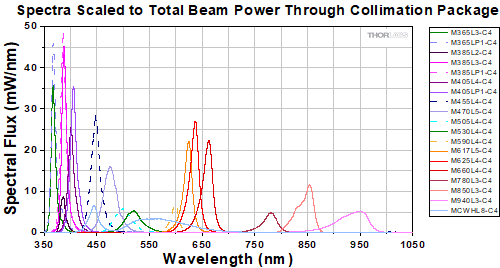
Click to Enlarge
上のグラフのデータのエクセルファイルはこちらからダウンロードいただけます。
LEDの寿命および長期的なパワー安定性
LEDの特性の1つとして、時間の経過と共にパワーが自然に低下することがあげられます。ほとんどの場合、パワーは緩やかに低下しますが、急速な低下や完全な停止、あるいは故障が突然起こることもあります。 LEDの寿命は、LEDの種類ごとに規定されたある割合のLEDが、あるパワーレベル以下に低下するまでの時間で定義されます。寿命測定のパラメータはBXX/LYYで表され、ここでXXはその種類のLEDで寿命が過ぎた後の出力パワーが規定値のYY%以下になるLEDの割合を示します。当社では、LEDの寿命をB50/L50で表しますが、これはその型番のLEDのうち50%のLEDの光パワーが規定の寿命がきた時に初期値の50%以下に低下するという意味です。例えば、定格出力パワー150 mWのLED100個のうち、50個の出力パワーが規定の寿命を過ぎたときに75 mW以下に低下するということです。
最適化された温度管理
このコリメート済みLEDの放熱特性は最適化されています。LEDパッケージのヒートシンクはLEDマウントのヒートシンクと直接熱的接触をしているので、放熱は適切な状態になっています。これにより、LED接合部の温度上昇に起因する光出力パワーの低下が最小限に抑えられます(右のグラフをご参照ください)。
| Pin | Specification | Color |
|---|---|---|
| 1 | LED Anode | Brown |
| 2 | LED Cathode | White |
| 3 | EEPROM GND | Black |
| 4 | EEPROM IO | Blue |

ピン接続:オス型
右の図は、コリメートしたLEDアセンブリのオス型コネクタを示しています。 これは、標準的なM8x1センサ円形コネクタです。 ピン1と2はLED接続用です。 ピン3と4はLEDに内蔵するEEPROMに使用されます。 当社以外のLEDドライバをご使用の場合、ピン1と2の接続は適切に行ってください。またEEPROMピンからLED駆動しないようご注意ください。
駆動するLEDからその最大光パワーを出力させるには、ドライバの最大電圧と最大電流が、それぞれLEDの最大電圧以上、最大電流以上であることが必要です。
| Compatible Drivers | LEDD1B | UPLEDa | DC2200a | DC4100a,b | DC4104a,b |
|---|---|---|---|---|---|
| Click Photos to Enlarge |  | 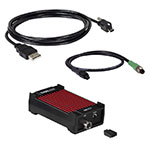 | 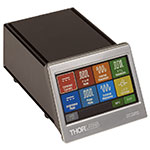 | 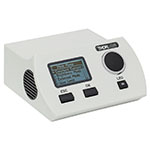 |  |
| LED Driver Current Output (Max)c | 1.2 A | 1.2 A | LED1 Terminal: 10.0 A LED2 Terminal: 2.0 Ad | 1.0 A per Channel | 1.0 A per Channel |
| LED Driver Forward Voltage (Max) | 12 V | 8 V | 50 V | 5 V | 5 V |
| Modulation Frequency Using External Input (Max) | 5 kHz | - | 250 kHze,f | 100 kHzf (Simultaneous Across all Channels) | 100 kHzf (Independently Controlled Channels) |
| External Control Interface(s) | Analog (BNC) | USB 2.0 | USB 2.0 and Analog (BNC) | USB 2.0 and Analog (BNC) | USB 2.0 and Analog (8-Pin) |
| Main Driver Features | Very Compact Footprint 60 mm x 73 mm x 104 mm (W x H x D) | USB-Controlled | Touchscreen Interface with Internal and External Options for Pulsed and Modulated LED Operation | 4 Channelsb | 4 Channelsb |
| EEPROM Compatible: Reads Out LED Data for LED Settings | - | ||||
| LCD Display | - | - |
| Posted Comments: | |
Yeon Jae Yoo
(posted 2022-11-01 08:57:41.63) Hello. My name is YeonJae Yoo, who works for LG Chem in Korea. I am writing this email because I have an inquiry regarding the purchase of a 365nm wavelength LED. If I buy this product, will the 365nm LED collimated beam come out without any other accessories? I want to know if I need to purchase another driver. Please reply by e-mail. hchow
(posted 2022-11-02 05:38:44.0) Hi Ms. Yoo, thank you for your enquiry. I will personally reach out to you to provide more information. user
(posted 2021-03-23 20:31:18.53) Dear sir,
I am looking for collimated LED light sources which are internally or externally SM2 threaded (like Solice LEDs). This would be very universal and convenient for integrating them with other thorlabs optics. They can be surely compatible with microscopes using, for example, SM2A13. I have a Solice LED for this purpose but need lighter one such as MCWHL6-C1. Alternatively, it would be great for you to provide adapters to fit MCWHL6-C1 to SM2 threaded parts. Thanks. MKiess
(posted 2021-03-25 11:13:07.0) Thank you very much for this feedback.
You can use a MCWHL6 LED in combination with a SM2F32-A, adjustable collimation adapter for Ø2" (Ø50 mm) Optics for this purpose. The MCWHL6 is the same LED that is also used for the MCWHL6-C1. You can screw the SM2F32-A collimator directly to this LED. The collimator has an internal SM2 thread for further integration. Patrick Lee
(posted 2021-03-09 11:23:47.873) Hi, I am interested in MCWHL6-C1.
I plan to use it as a collimated light source to shine on a test object, in order to cast a shadow on a diffuser glass.
A camera is placed at back of diffuser to pick up the shadow.
a) what is divergence output ?
b) will shadow be sharp ?
c) any recommendation for power supplier ?
Thank you. MKiess
(posted 2021-03-11 08:59:36.0) Dear Patrick,
Thank you for your inquiry.
A suitable LED driver for the MCWHL6-C1, is the LEDD1B or the DC2200. The divergence and sharpness of the shadow depends on your overall optical system of diffuser and lenses used, as well as the camera parameters. I have contacted you directly to discuss the details. user
(posted 2021-02-13 00:38:28.523) Hi, I am interested in using the MCWHL6-C5 to replace a 12V100W halogen lamphouse on my Nikon microscope. Roughly speaking, would the total output (477 mW) be comparable to the total output of the halogen bulb? MKiess
(posted 2021-02-15 11:03:51.0) Thank you very much for your inquiry. It depends on what the exact output power of the halogen lamp is. I assume that it will be a little higher than that of this LED. Cold white, LEDs with higher output power, which can also be connected to the Nikon microscope with corresponding collimators or adapters (As can be found, for example, under the following link.: https://www.thorlabs.de/newgrouppage9.cfm?objectgroup_id=8706) would be the SOLIS-1C and the MCWHLP1.
I have contacted you directly to discuss the exact requirement together. Hajun Song
(posted 2020-11-09 01:50:49.14) I want to use this model as a flash lamp for the high speed camera. What is the eletrical bandwidth of the laser? Is it possble to modulate the LD as a short pulse modulation? How narrow? wskopalik
(posted 2020-11-09 10:39:33.0) Dear Hajun,
Thank you very much for your feedback.
Unfortunately we do not have any data about the rise time of the M780L3-C1. Usually the bandwidth of LEDs is limited by the driver electronics rather than by the LED itself. So the specifications of the driver would need to be considered in most cases.
A good assumption for the rise time of an LED without phosphor like the M780L3-C1 is the range of at least 100 ns. This corresponds to an 3dB bandwidth of 3.5 MHz. Phosphor-converted LEDs (e.g. for white light) can however be considerably slower than that.
I will contact you directly so we can talk about your requirements in more detail. yefan8900
(posted 2019-02-07 15:20:32.607) can you please recommend me a led driver of this led? 1600 mA swick
(posted 2019-02-15 05:12:49.0) This is a response from Sebastian at Thorlabs. Thank you for the inquiry.
Our DC2200 can be used to drive LEDs at 1600 mA. yefan8900
(posted 2019-02-07 14:11:44.557) what's the beam power of M470L2-C3 - Blue (470 nm)? the spec sheet does not have such information. only have information about M470L2-C1, M470L2-C2, M470L2-C4, M470L2-C5. nreusch
(posted 2019-04-15 10:48:41.0) This is a response from Nicola at Thorlabs. Thank you for your inquiry! The total beam power is 300 mW. I will send you the spec sheet via email. yefan8900
(posted 2019-02-06 22:17:30.557) Can you send me the spec sheet of M470L2-C3? The spec sheet above did not include M470L2-C3, which is very weird. nreusch
(posted 2019-04-15 10:48:38.0) Thank you for your inquiry! Please find my response below your second post. e.zherebtsov
(posted 2017-08-04 02:35:01.72) Could you consult me please whether it is possible to modulate the LEDs at 365 nm with frequency ~50 MHz. Thanks a lot. tschalk
(posted 2017-08-07 09:13:59.0) This is a response from Thomas at Thorlabs. These high power LEDs are not well suited to perform a modulation in the MHz range. We will contact you directly with more detailed information. iravkin
(posted 2017-08-02 09:50:36.14) Could you explain the procedure and the light meters used to measure the Total Beam Power at the output aperture of collimated LED light sources? Do you offer the required power meters if I want to perform these measurements in my lab? tfrisch
(posted 2017-08-16 10:36:19.0) Hello, thank you for contacting Thorlabs. These collimated LEDs are measured using an integrating sphere which is unfortunately not a component we offer. We will reach out to you directly as well. tzangle
(posted 2017-01-18 22:29:19.993) What is the "separate adapter that is available from Olympus." that may be necessary to use this with an IX series microscope as a transmitted light source? wskopalik
(posted 2017-01-24 06:24:23.0) This is a response from Wolfgang at Thorlabs. Thank you very much for your inquiry.
The collimated LED light sources for Olympus BX and IX microscopes can be directly attached to the epi-illumination port of these microscopes. For the transmission-illumination port we might be able to offer a suitable collimator as a special.
I have contacted you directly to provide further information and to discuss the issue in more detail. bmsalzbe
(posted 2016-02-29 11:41:02.43) Need amplitude noise information at 530 nm and 470 nm shallwig
(posted 2016-03-03 09:53:52.0) This is a response from Stefan at Thorlabs. Thank you very much for your inquiry. I will contact you directly to check your setup and your application in detail. giulia.mazza
(posted 2014-03-20 10:48:54.817) Hello! The LED M455L3 would suite my application, I'm looking for possibilities to collimate it correctly ideally in a small beam with low divergence.. I do not need it for microscopy.
A 5 cm diameter beam is quite big but if the collimation is good I could resize it with further optics, so the first question is "which is the divergence of the beam after collimation in the product M455L3-C1"?
Second question, are there other possibilities to collimate the M455L3 LED in for example a < 1.5 cm beam with divergence < 5°? How much power loss should it cause?? Thanks in advance!!! jvigroux
(posted 2014-04-10 10:10:14.0) A response from Julien at Thorlabs: Thank you for your inquiry! The divergence of the M455L3-C1is typically of about 3° and in best case slightly less than 2°, so that in principle it would be possible to resize the beam after the 2" output. By using another collimating lens than the standard 2" diameter 40mm focal length, one can further reduce the output collimated beam. I will contact you directly to discuss the requirements in termsof powe and divergence in order to see which option would work best in your case. mwinkler.its-b2011
(posted 2013-09-26 07:33:22.427) Hello,
I have bought the MCWHL5-C1 and I would like to mount it externally on a bar to a device.
Sadly I am not sure which mount I should best use where I can put the device in and connect it to the bar with screws.
Can you recommend me a device from your catalogue which is best suited for that?
Thanks in advance tschalk
(posted 2013-10-04 08:15:00.0) This is a response from Thomas at Thorlabs. Thank you very much for your inquiry. To mount our collimated LED light sources you can use a lens tube slip ring SM1RC: https://www.thorlabs.de/newgrouppage9.cfm?objectgroup_id=1533&pn=SM1RC#2714. I will contact you directly with more detailed information. mhunter
(posted 2013-09-11 14:07:09.973) I am very interested in using an LED light source in place of a 100 watt halogen lamp -- in the EPI illuminators of my (6) Nikon Optiphot 150 microscopes. We are primarily using brightfield and DIC imaging.
Would your mounted LEDs (probably cool white or green) work in this application?
Thanks, Mike Hunter tschalk
(posted 2013-09-13 09:50:00.0) A response from Thomas at Thorlabs. Thank you very much for your inquiry. At the moment we don’t have an adapter which is suitable for the Nikon Optiphot 150 microscopes. I will contact you directly to check if we can find a solution. B.Povazay
(posted 2013-03-12 19:54:38.977) Is it possible to mount collimated LEDs in a standard SM1-mount? tcohen
(posted 2013-03-14 13:37:00.0) Response from Tim at Thorlabs: The back end of these have 1.2” diameters and can be used with an SM1RC slip ring. The beam diameters produced by these larger focal length lenses would overfill an SM1 thread. If you are looking to confine it to this size an alternative would be to use the mounted LED without the collimating optic, (this is the M***L2 series and can be purchased separately) and then use a 1” diameter lens with an adjustable length lens tube for alignment. We have a typical setup to this end on our “Application” tab on the M***L2 series page. jvigroux
(posted 2012-10-22 08:48:00.0) A response form Julien at Thorlabs: Thank you for your inquiry! As far as I know, DIC usually uses polarized light sources. If this is the cas ein your setup, the LEd would not work because of the light being unpolarized. The use of an extra polarizer after the LED would imply a strong power reduction as well as a relatively high instability of the output power. I will contact you directly to discuss the details of your setup in order to see which light source could be used. nrbabuwp
(posted 2012-10-18 18:45:29.41) Hi,
We are interested in buying an LED to replace the lamp of DIC to use it in multicolor imaging. Wavelength range we are looking for is between 670 and 750nm. Can you suggest if 260mW of 735nm LED is good enough for DIC imaging? Has anyone used it for DIC?
Babu jvigroux
(posted 2012-01-23 10:30:00.0) A response from Julien at Thorlabs: Thank you for your feedback! the suggested adapters are by no mean the only solution and based on the details of your setup, some other configuration might indeed improve the power density or the homogeneity. I will contact you directly to discuss the details and see which solution would be the most adapted. g.raffy
(posted 2012-01-23 09:12:12.0) A collimated beam with 50mm diameter will be clipped by the back aperture of the objective in an IX microscope (~10mm), loosing most of the available power of the LED. Am I wrong?
Why not proposing an alternative lens that lets all the light entering the objective? I really need all the power...
Ideally, if the lens to LED distance is settable, then one could choose between power density and uniformity of illumination. bdada
(posted 2011-09-21 14:55:00.0) Response from Buki at Thorlabs:
Thank you for your interest in our MCWHL2-C1 and for taking the time to use our feedback tool! These mounts are designed to fit on the standard and epi-illumination ports for Olympus BX and IX microscopes. The exact compatibility will depend on whether the transmitted lamp housing on your desired Olympus microscope has the same port-style as the BX and IX.
Please contact TechSupport@thorlabs.com if you have further inquiries. mzlin
(posted 2011-09-02 12:01:15.0) Can anyone verify that the Olympus mounts will fit in place of the transmitted lamp housing too (i.e. the same mount will work for transmitted as for fluorescence)? We have not gotten our scope yet so cant measure ourselves. Thanks. klee
(posted 2009-10-05 16:12:24.0) A response from Ken at Thorlabs: Our new DC2100 is also plug and play compatible with these LED light sources. acable
(posted 2009-10-03 15:47:55.0) Is the LEDD1 driver the only driver you offer that is plug and play compatible. |
こちらのページでは当社が販売するすべてのLEDをご覧いただけます。More [+]をクリックすると、下の各LED製品の波長をご覧いただけます。
| Light Emitting Diode (LED) Selection Guide | ||||||
|---|---|---|---|---|---|---|
| Click Photo to Enlarge (Representative; Not to Scale) |  |  |  |  |  |  |
| Type | Unmounted LEDs | Pigtailed LEDs | LEDs in SMT Packages | LED Arrays | LED Ring Light | Cage-Compatible Diffuse Backlight LED |
| Light Emitting Diode (LED) Selection Guide | ||||||
|---|---|---|---|---|---|---|
| Click Photo to Enlarge (Representative; Not to Scale) |  |  |  |  |  |  |
| Type | PCB- Mounted LEDs | Heatsink- Mounted LEDs | Collimated LEDs for Microscopyb | Fiber- Coupled LEDsc | High-Power LEDs for Microscopy | Multi-Wavelength LED Source Optionsd |

- ビーム径:約 50 mm
- ビーム面積:約 1960 mm²
- ARコーティング付き非球面コリメートレンズ(EFL = 40 mm)
- 仕様の詳細については「仕様」タブ参照
- ケーブルの長さ: 2 m

- ビーム径:約37 mm
- ビーム面積:約1080 mm²
- ARコーティング付き非球面コリメートレンズ(EFL = 40 mm)
- 仕様の詳細については「仕様」タブ参照
- ケーブルの長さ: 2 m

- ビーム径:約44 mm
- ビーム面積:約1520 mm²
- Zeiss製AxioskopおよびExaminer顕微鏡のアリ溝に対応
- ARコーティング付き非球面コリメートレンズ(EFL = 40 mm)
- 仕様の詳細については「仕様」タブ参照
- ケーブルの長さ: 2 m

- ビーム径:約43 mm
- ビーム面積:約1450 mm²
- ARコーティング付き非球面コリメートレンズ(EFL = 40 mm)
- 仕様の詳細については「仕様」タブ参照
- ケーブルの長さ: 2 m

- 4ピンメスPico型(M8)レセプタクル
- マウント付きLEDの電源ケーブル接続用M8 x 1ネジ
- パネル取付け用M8 x 0.5ネジ、カスタム筐体用
- 長さ0.5 mのAWG24ケーブル
- IP 67およびNEMA 6P規格準拠
コネクタCON8ML-4をご使用いただくことで、お手持ちの電源を当社のマウント付きLEDに接続することができます。当社では4ピンオス型M8接続ケーブル(型番CAB-LEDD1)もご用意しております。
| Pin | Color | Specification |  |
|---|---|---|---|
| 1 | Brown | LED Anode | |
| 2 | White | LED Cathode | |
| 3 | Black | EEPROM GND | |
| 4 | Blue | EEPROM IO |

マウント付きLEDの4ピンM8プラグに接続しているCON8ML-4
 Products Home
Products Home














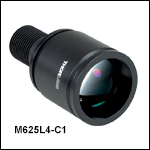
 ズーム
ズーム
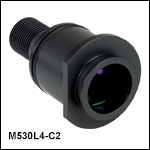


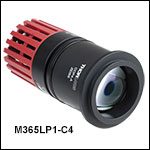


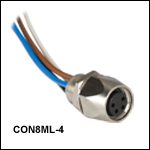
 顕微鏡用LED照明、コリメータ付き
顕微鏡用LED照明、コリメータ付き